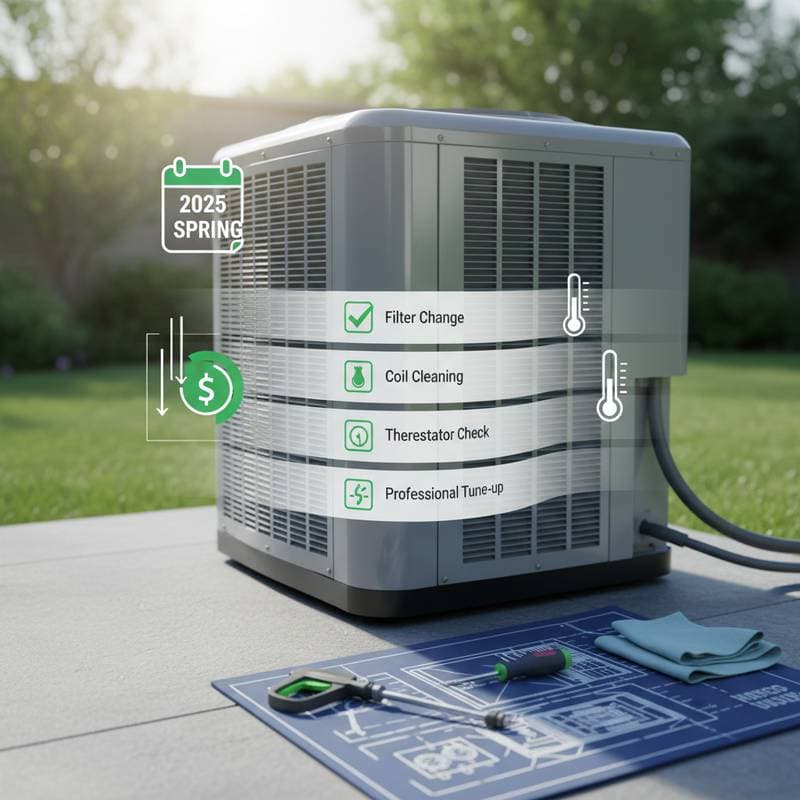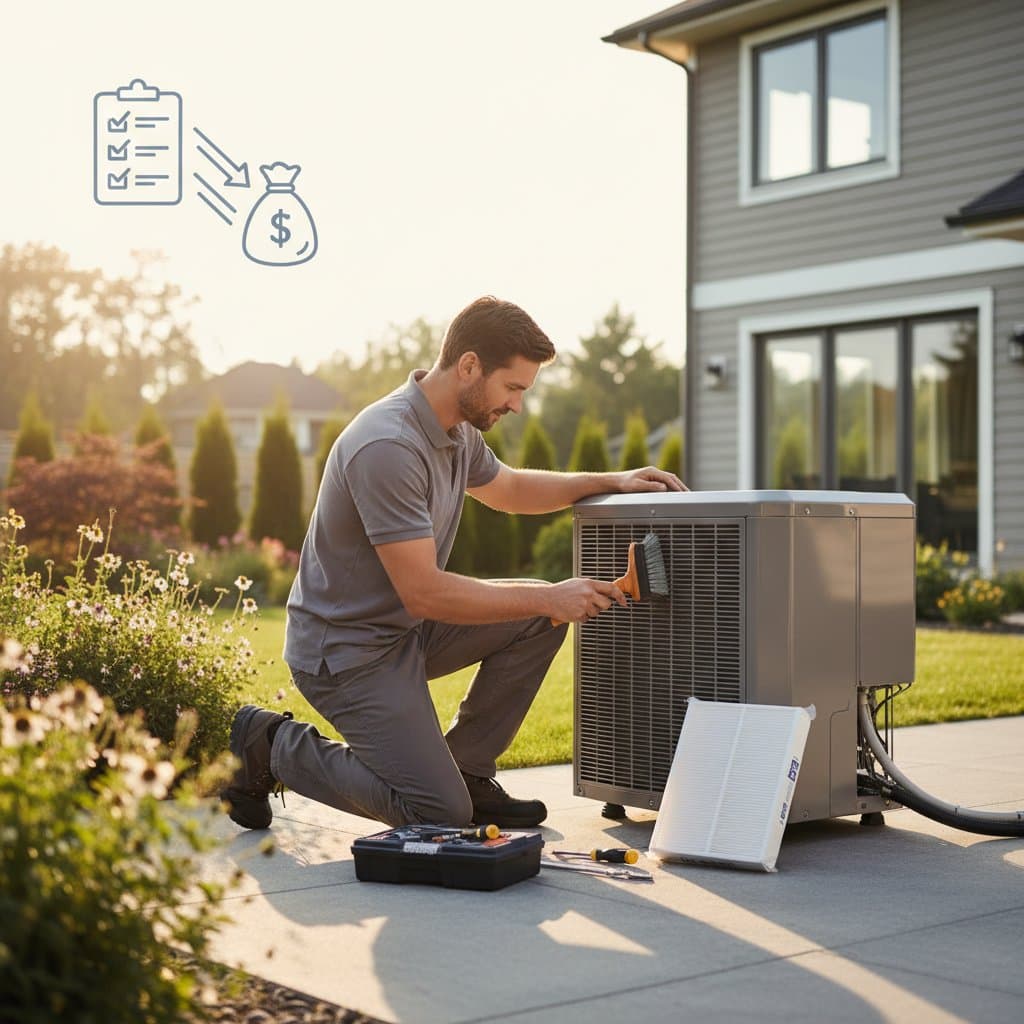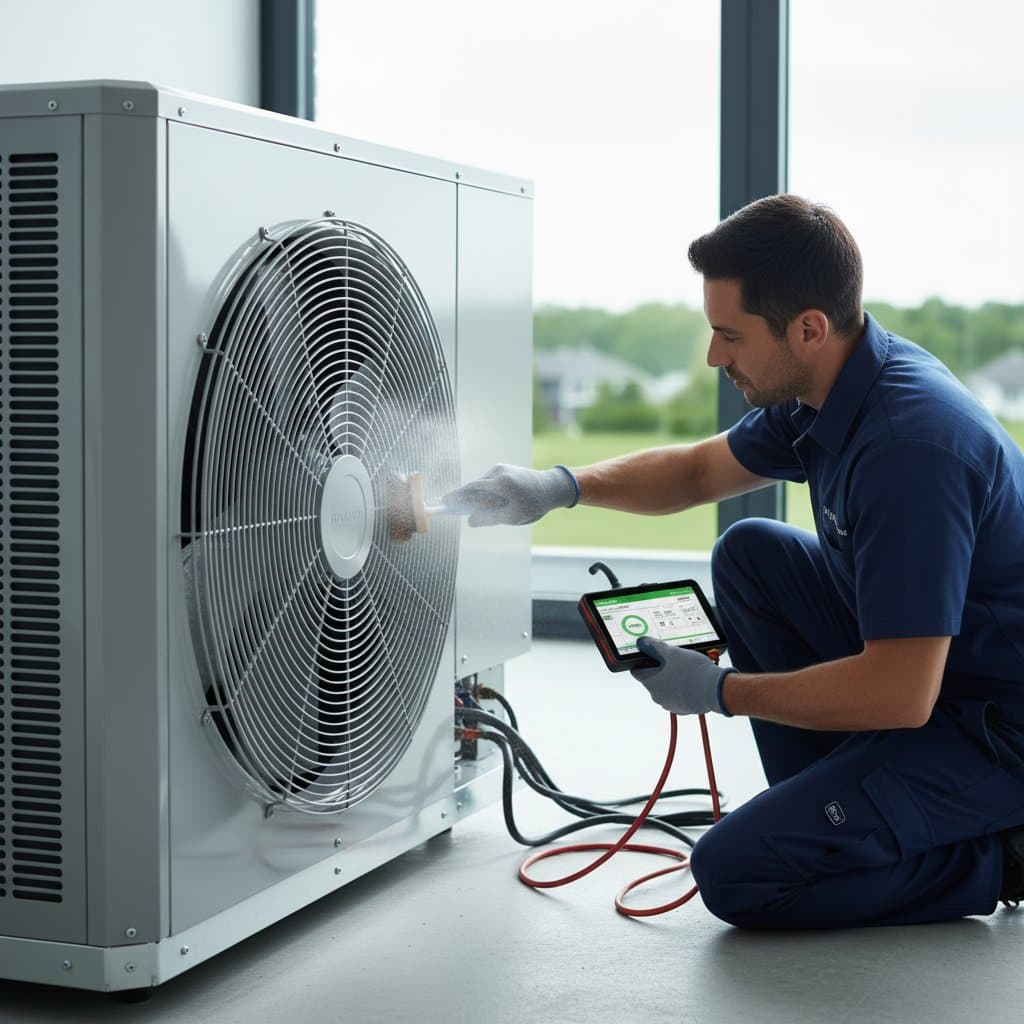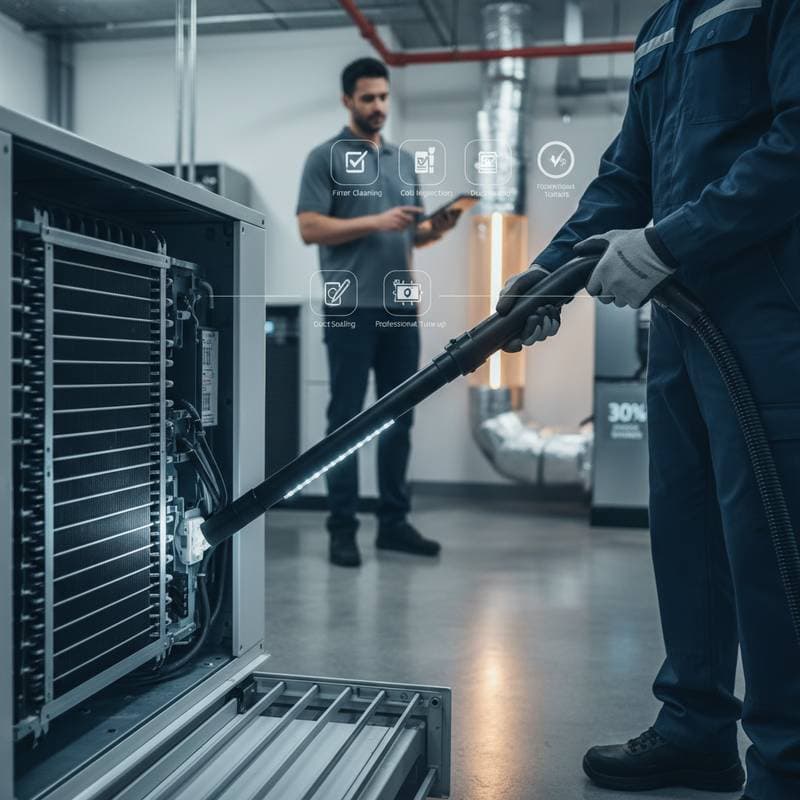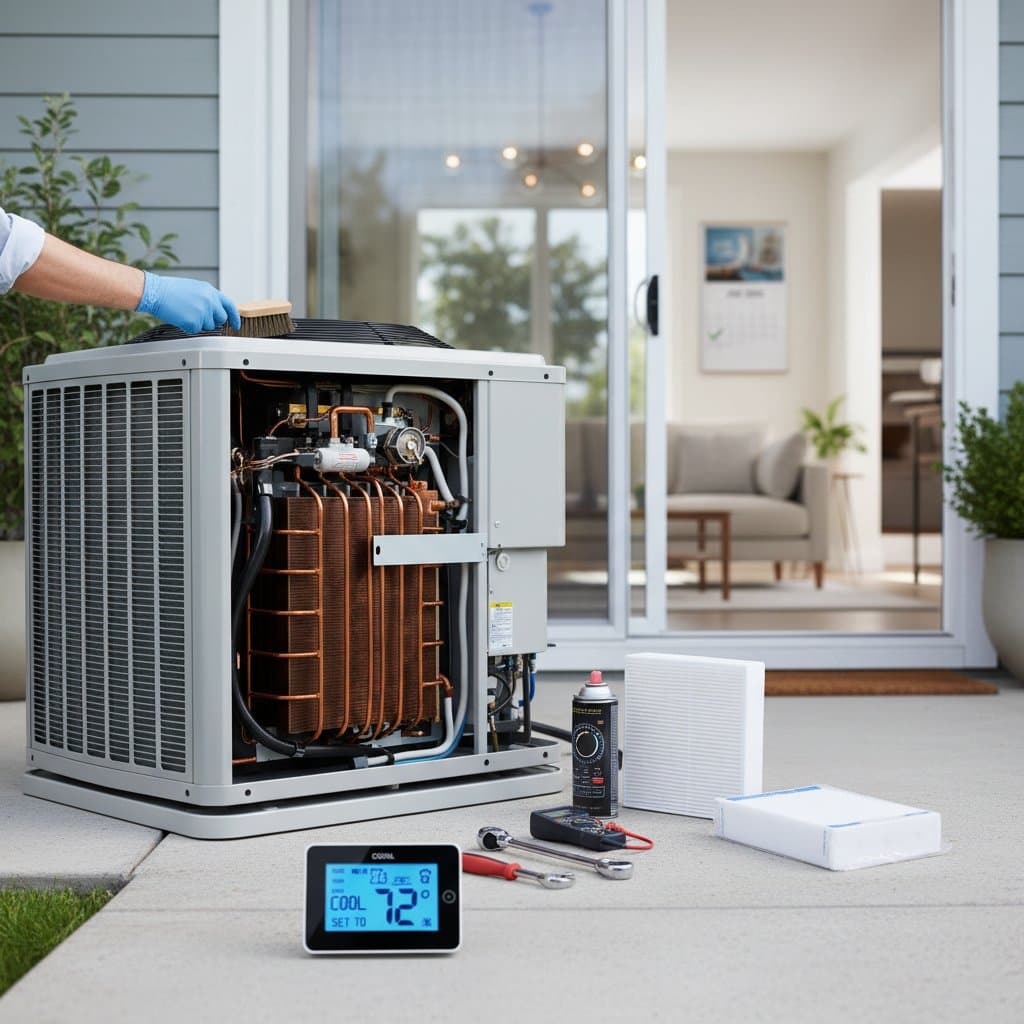Prevent Costly AC Failures with Spring Maintenance
Rising temperatures bring the risk of air conditioner breakdowns, leaving homeowners uncomfortable and facing unexpected expenses. Spring maintenance prepares your system for summer demands, avoiding emergency repairs and optimizing performance. This guide provides a complete plan, including essential tasks and professional recommendations, to maintain efficiency and comfort.
Why Spring AC Maintenance Is Essential
Air conditioners endure intense operation during hot months, straining components if neglected. Routine spring checks address issues like dirty filters or refrigerant shortages before they escalate. Such preventive measures enhance energy efficiency, extend equipment life, and improve indoor air quality by reducing dust circulation.
Early detection of problems allows for scheduled fixes, sparing you from peak-season delays. Homeowners who maintain systems proactively report fewer interruptions and lower utility expenses throughout the year.
Comprehensive Spring AC Maintenance Checklist
Follow this step-by-step checklist in early spring to ready your air conditioner for summer. Each task targets common failure points, ensuring reliable operation.
1. Replace or Clean Air Filters
Clogged filters impede airflow, causing the system to overwork and lose efficiency. Homeowners should replace disposable filters or wash reusable ones every one to two months, with more frequent attention during high-pollen seasons.
Select filters with a MERV rating of 8 to 13 for optimal filtration, provided your unit accommodates them without straining airflow.
2. Clean the Outdoor Condenser Unit
Debris accumulation on the outdoor unit hinders heat dissipation, reducing cooling capacity. Disconnect power before clearing leaves, dirt, or vegetation from the coils and surrounding area.
Rinse coils gently with a hose, maintaining at least two feet of clearance around the unit. Steer clear of high-pressure sprays to prevent fin damage.
3. Verify Thermostat Accuracy
An inaccurate thermostat leads to inefficient cycling and discomfort. Test by comparing its reading to a separate thermometer; recalibrate or upgrade if discrepancies exceed two degrees.
Programmable models automate adjustments, such as raising temperatures during absences, to conserve energy without sacrificing comfort.
4. Examine Ductwork for Leaks
Duct leaks squander up to 30 percent of cooled air, resulting in higher bills and inconsistent temperatures. Inspect accessible joints for gaps or deteriorated insulation.
Apply mastic sealant or foil tape to minor leaks; professionals handle extensive repairs to restore full system integrity.
5. Review Electrical Connections
Corroded or loose wiring poses fire risks and triggers failures. Conduct a visual check for fraying or burn marks, but refrain from handling live components.
Technicians assess voltage, capacitors, and connections during inspections to safeguard against electrical faults.
6. Clear the Condensate Drain Line
Clogs in the drain line from algae buildup cause water damage and humidity spikes. Pour a vinegar-water solution through the line to dissolve obstructions, confirming free drainage.
Install a drain pan if absent, and schedule annual professional flushes for thorough prevention.
7. Clean Evaporator and Condenser Coils
Dirt on coils impairs heat transfer, prompting inefficiency or freezing. Vacuum accessible evaporator coils and inspect for frost; condenser coils require similar attention outdoors.
Professionals use specialized tools for deep cleaning, avoiding abrasive methods that etch surfaces.
8. Lubricate Moving Parts
Friction in motors and fans accelerates wear if lubrication lapses. Locate oil ports on accessible components and apply manufacturer-specified lubricant sparingly.
This simple step quiets operation and prevents premature part replacement.
9. Evaluate System Performance
Run the unit for 15 to 20 minutes post-maintenance, monitoring airflow, noise levels, and temperature drops. Weak output or odd sounds signal underlying concerns.
Document observations to inform professional assessments if needed.
10. Arrange a Professional Tune-Up
Expert inspections uncover hidden issues like refrigerant imbalances or component wear. Technicians calibrate systems, test pressures, and certify safety.
Annual tune-ups, performed in spring, align with manufacturer guidelines and preserve warranty coverage.
Issues Avoided Through Spring Maintenance
Consistent upkeep thwarts several expensive problems:
- Compressor overload from restricted airflow or refrigerant deficits
- Coil freezing due to contaminants or ventilation blocks
- Short cycling that stresses components through rapid on-off patterns
- Leaks from obstructed drains or iced evaporators
- Uneven cooling tied to duct inefficiencies or sensor errors
Addressing these proactively minimizes repair costs and sustains even temperatures.
Balancing DIY and Professional Tasks
Homeowners can manage routine checks safely, but complex work demands expertise to avoid voids in warranties or hazards.
Tasks for Homeowners
- Filter servicing and outdoor unit clearing
- Drain line flushing and thermostat adjustments
- Basic visual scans for leaks or debris
Tasks Requiring Professionals
- Refrigerant management and electrical diagnostics
- In-depth coil cleaning and motor repairs
- Comprehensive duct sealing and system calibration
Engaging certified technicians ensures compliance with codes and optimal results.
Frequently Asked Questions on AC Maintenance
How frequently should air conditioners receive service?
Annual professional servicing suffices for most units, timed before summer to preempt issues.
What indicates urgent AC repairs?
Warm vent air, strange sounds, constant cycling, or unit leaks warrant immediate professional intervention.
Is temporary operation without a filter advisable?
No; unfiltered air circulates contaminants, harming internal parts and air quality.
What is the expected lifespan of an AC unit?
Properly maintained systems endure 10 to 15 years, influenced by model quality and environmental factors.
What thermostat setting optimizes summer efficiency?
Maintain 75 to 78 degrees Fahrenheit when occupied, increasing by 4 to 7 degrees during absences.
How can cooling expenses be reduced?
Employ fans, shade windows, and uphold maintenance to maximize system performance.
Does constant AC operation on extreme days signal trouble?
Occasional prolonged runs occur in severe heat, but nonstop operation suggests filter or refrigerant problems.
Is winter covering of outdoor units necessary?
A permeable cover shields from debris without trapping moisture; tight seals promote corrosion.
Does refrigerant shortage cause coil icing?
Yes; insufficient levels hinder heat exchange, leading to frost and diminished airflow.
Which filters suit allergy sufferers?
MERV 11 to 13 ratings effectively trap allergens like pollen and dander.
Steps to Plan Your Spring AC Maintenance
1. Evaluate Current System Health
Review age, repair history, and cooling consistency. Aging units may benefit from upgrades over mere maintenance.
2. Gauge Your Capabilities
Tackle simple tasks with basic tools; delegate technical elements to avoid risks.
3. Weigh Costs and Benefits
Factor in repair savings, energy reductions, and potential replacement expenses for informed budgeting.
4. Prioritize Safety and Compliance
Adhere to guidelines to protect warranties and prevent accidents; certified pros ensure adherence.
5. Execute and Monitor
Complete tasks systematically, logging progress for ongoing reliability.
Steps to Launch Your Maintenance Routine
Consult your unit's manual for model-specific intervals. Assemble supplies like filters, cleaners, and sealants. Secure appointments early to bypass seasonal rushes. Relocate obstructions near the outdoor unit. Maintain a log of all activities to track patterns and schedule future services.
Sustaining Peak AC Performance Year-Round
Spring preparation sets the foundation for seamless summer cooling. Regular adherence to this checklist delivers comfort, efficiency, and longevity, transforming your home into a cool retreat amid rising heat.
